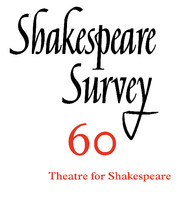Book contents
- Frontmatter
- Professional Players in the Guild Hall, Stratford-upon-Avon, 1568–1597
- Reconstructing The Rose: Development of the Playhouse Building between 1587 and 1592
- The Rose and its Stages
- Philip Henslowe and the Elizabethan Court
- From Revels to Revelation: Shakespeare and the Mask
- Bride-ing the Shrew: Costumes that Matter
- ‘When Men and Women are Alone’: Framing the Taming in India
- The Crown and the Pillow: Royal Properties in Henry IV
- Humanity at Stake: Man and Animal in Shakespeare’s Theatre
- Popular Shakespeare in Japan
- ‘Philosophy in a Gorilla Suit’: Do Shakespearians Perform or Just Perform-a-tive?
- Sudokothellophobia: Writing Hypertextually, Performatively
- Living Monuments: The Spatial Politics of Shakespeare’s Rome on the Contemporary Stage
- ‘In Windsor Forest and at the Boar’s Head’: The ‘Falstaff Plays’ and English Music in the Early Twentieth Century
- Michael Bogdanov in Conversation
- The Mouse and the Urn: Re-Visions of Shakespeare from Voltaire to Ducis
- ‘I covet your skull’: Death and Desire in Hamlet
- Martin Droeshout Redivivus: Reassessing the Folio Engraving of Shakespeare
- Canonizing Shakespeare: The Passionate Pilgrim, England’s Helicon and the Question of Authenticity
- Rereading Shakespeare: The Example of Richard Brathwait
- Shakespeare Performances in England, 2006: January 2006
- Professional Shakespeare Productions in the British Isles January–December 2005
- he Year's Contributions to Shakespearian Study 1 Critical Studies
- 2 Shakespeare in Performance
- 3 Editions and Textual Studies
- Index
3 - Editions and Textual Studies
Published online by Cambridge University Press: 28 November 2007
- Frontmatter
- Professional Players in the Guild Hall, Stratford-upon-Avon, 1568–1597
- Reconstructing The Rose: Development of the Playhouse Building between 1587 and 1592
- The Rose and its Stages
- Philip Henslowe and the Elizabethan Court
- From Revels to Revelation: Shakespeare and the Mask
- Bride-ing the Shrew: Costumes that Matter
- ‘When Men and Women are Alone’: Framing the Taming in India
- The Crown and the Pillow: Royal Properties in Henry IV
- Humanity at Stake: Man and Animal in Shakespeare’s Theatre
- Popular Shakespeare in Japan
- ‘Philosophy in a Gorilla Suit’: Do Shakespearians Perform or Just Perform-a-tive?
- Sudokothellophobia: Writing Hypertextually, Performatively
- Living Monuments: The Spatial Politics of Shakespeare’s Rome on the Contemporary Stage
- ‘In Windsor Forest and at the Boar’s Head’: The ‘Falstaff Plays’ and English Music in the Early Twentieth Century
- Michael Bogdanov in Conversation
- The Mouse and the Urn: Re-Visions of Shakespeare from Voltaire to Ducis
- ‘I covet your skull’: Death and Desire in Hamlet
- Martin Droeshout Redivivus: Reassessing the Folio Engraving of Shakespeare
- Canonizing Shakespeare: The Passionate Pilgrim, England’s Helicon and the Question of Authenticity
- Rereading Shakespeare: The Example of Richard Brathwait
- Shakespeare Performances in England, 2006: January 2006
- Professional Shakespeare Productions in the British Isles January–December 2005
- he Year's Contributions to Shakespearian Study 1 Critical Studies
- 2 Shakespeare in Performance
- 3 Editions and Textual Studies
- Index
Summary
This annus mirabilis in Shakespearian editing welcomed two monumental editions: the Arden3 Hamlet and the Oxford Othello. I don't imagine that there are many Shakespearians on the planet who did not know of Arden's long-announced plan to present a groundbreaking edition of all three textual versions of Hamlet. The fact that Ann Thompson and Neil Taylor have prepared critical editions of q1, q2 and f – the latter two being the longest texts in the Shakespeare canon – in about a decade is an extraordinary achievement (it took Harold Jenkins thirty-six years to finish his Arden2 edition). Just as the 1982 Arden2 Hamlet marked the culmination of the tradition of conflated editions, Arden3 is a milestone in the recent history of version-based editing.
Thompson and Taylor have produced unapologetically conservative editions of all three texts. Those of us who have criticized version-based editions that do not follow their control texts will find much to applaud here. This is version-based editing at its best. Their Second Quarto text makes remarkably few emendations (128 compared to Jenkins's 297) and their Folio text preserves many more f readings than any previous Folio-based edition. My personal favourite comes in the opening line to 1.4 where Folio editors such as Gary Taylor, Philip Edwards and G. R. Hibbard all emend f's 'is it very cold?' to Q2's 'it is very cold'. Thompson and Taylor are surely correct in retaining this small but essential difference: Hamlet in the Folio is so distracted that he does not know whether it is cold or not and has to ask.
- Type
- Chapter
- Information
- Shakespeare Survey , pp. 361 - 369Publisher: Cambridge University PressPrint publication year: 2007
- 1
- Cited by

